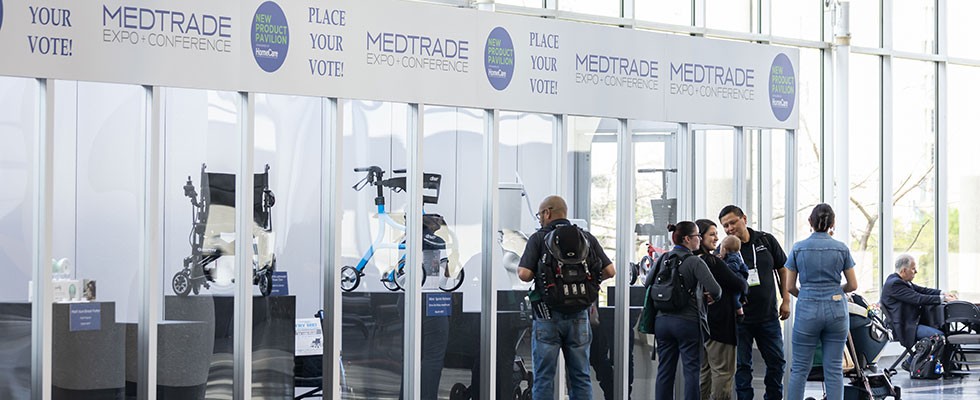
Securing better reimbursement rates and moving to new technologies like e-prescribing are the top priorities for home medical equipment (HME) advocates in 2023, industry leaders said at Medtrade, the country’s largest HME conference and tradeshow, held March 28-30 in Dallas.
Attendees and experts also focused on new and returning products and other budding industry concerns, including a shift to value-based care, the meteoric rise of managed care and much more. The show was held at the end of March in Dallas—the first time for a single annual show in a new location, and show organizers said it was a success.
Perhaps the top item on the 2023 to-do list is making sure the 75%/25% blended rate for non-rural areas not subject to competitive bidding lasts beyond December 2023, said Tom Ryan, president and CEO of the American Association of Homecare (AAHomecare), who spoke at the organization’s annual update.
“That is a life preserver,” Ryan said about the blended rate, which was instituted during the COVID-19 public health emergency (PHE) and included in the 2022 omnibus spending bill. If not extended, it will expire at the end of 2023.
Another major focus is persuading more providers to switch to e-prescribing and other technologies that will allow them to better interface with referral sources and better collect data. That data, in turn, should help convince payers of the value HME brings to the health care continuum.
“The question is not if but when, and
what does it take to get there,” said Bill Guidetti, AAHomecare’s board chair and president and president of the East Region at Apria Healthcare.
“I think we all should embrace it and if we do, I’m telling you it’s a game changer for this industry,” he said.
Value-Based Care at the Fore
Another significant shift for HME may come from the broader turn to value-based care in the post-acute care field, participants said. The move may be a boon for durable medical equipment (DME), but it will also require additional work in terms of gathering data and educating primary care doctors and payers about the role providers can play.
In fact, by 2030, all reimbursement—including HME/DME—will be based on value-based care, John Zelczak, vice president of respiratory sales at Drive Medical, said in a conference session.
“Don’t stick your head in the sand and say I’m dealing with billing HCPS codes forever. Because it’s coming,” he said. “Our industry is telling us that it’s coming and to get ready.”
It will also require equipment providers to step into clinicians’ shoes, Karen Lerner, Drive’s clinical vice president, said in the same session.
“As we move to value-based care, I think it’s very important that DME providers understand things more from a clinical perspective because that’s who you’re going to be dealing with,” she said.
“Trust me, you’re not the only ones struggling with defining this,” Allen Hunt, president of Hart Medical Equipment, said in a panel discussion on value-based are. “A lot of the hospitals and health systems are struggling with this as well … don’t feel bad if you’re not an expert at it.”
Other Concerns for Attendees
During the conference sessions, larger meetings and general conversation on the show floor, other items rose to the surface, including:
1. Managing Medicare Advantage Plans: In one session, almost every hand in the room went up when the audience was asked who was already working with MA patients.
“You have no choice but to wrestle with these companies, to make sure that you can keep servicing the elderly patients who walk through your door who need care,” Andrea Stark, cofounder of Miravista told them.
2. The End of the Public Health Emergency: When the COVID-19 public health emergency (PHE) closes this month, several flexibilities providers have enjoyed will also end, including softer rules for respiratory, continuous glucose monitoring and home infusion products; timely filing requirements for Medicare claims and appeals; waived signatures for proof of HME delivery; expedited processing for new and pending enrollments and HIPAA compliance allowances for telehealth.
Experts are still waiting for additional guidance on other questions, including how to handle rental DME that was set up before May 11.
“We are actively asking for it, the Medicare Administrative Contractors are aware and awaiting (Centers for Medicare & Medicaid Services) directives,” said Jeff Baird, chairman of the health care group at Brown & Fortunato. “I know that you guys are going to get guidance. This is going to come out shortly.”
3. Staffing: Hiring, rapid turnover and managing an increasingly remote workforce are all top of mind for HME providers.
“It’s a significant issue,” Guidetti said. “The workforce is changing, it’s harder to manage the workforce. You’ve got to build flexibility in the job scope, you have to let them work through telehealth, work from home a couple of days a week. Making the job seem very rewarding is not going to get it done—you need to think about the current environment that we’re in.”
Continuous Change
The pandemic and a wide range of other changes have led to dramatic shifts in how the industry is viewed—and how it needs to operate—said Josh Marx, incoming AAHomecare board chair and CEO of Medical Service Company.
“Over the last few years, consumer expectations have changed,” he said, and the focus has switched to managing patient care in the home.
“We should not be looking at our industry as a retail medical equipment company or a last-mile delivery company. We’re a disease management company,” he said.
Making that clear to consumers and to Congress is an important task moving forward, Guidetti said.
“Once we demonstrate that value, it’s undeniable because that’s where health care is going,” he said. “Think about the big payers out there … Where do they want to spend the big dollars? At home.”
